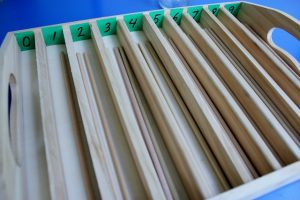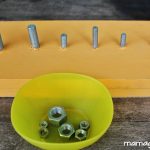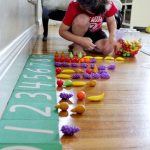Montessori is the best early childhood education, but materials can be expensive. With just a little bit of effort many of them can be made at home. The Spindle Box is a staple in Montessori math and it is very easy to make. Making it at home costs about $3.00. Purchasing one starts at $30.00, plus shipping. It takes less than an hour create a beautiful box that will stand the test of time.
Materials Needed
unfinished wood tray (purchased for a few dollars at the craft store)
9 small wooden slats cut to fit the interior width of your tray
wood glue
nails
small green papers labeled with the numbers 0-9
45 wooden dowels (ours are 3/16×48′ cut down to size)
1. Space the wooden slats at even intervals to make 10 compartments. Bead some wood glue on the bottom of the slat and nail the sides into position.
2. Glue the green numbers along the top of the tray, labeling each compartment.
3. Cut dowels so that they are long and even.
How to Present the Spindle Box
This is taught after number rods and sandpaper numbers. Your child should be able to identify numbers in order to begin this activity.
1. Sit your child at a mat and give him the jar of spindles. Point to the first number, zero. Say, “Zero, that means nothing, so I won’t put anything there.”
2. Move on to the next number. Point and ask your child what number that is. He’ll say, “One.” Invite him to place one spindle in the compartment. Continue until all of the spindles are put in the correct spots. Be slow and methodical.
3. Do not correct any mistakes, but encourage careful concentration. This is a self-correcting activity. If he makes a mistake he will not have the correct number left at the end. Assure him that that is OK, but then show him how to double check his work to find the error. The exception is if he keeps putting something in the zero compartment. Help him learn that concept.
4. Place this activity in an accessible location and encourage your child to use it often.
Benefits of Using the Spindle Box
This activity strengthens counting abilities and is excellent tactile learning.
The concept of zero is strongly emphasized. Counting doesn’t start at 1.
The self-correcting mechanism built-in allows a child to work independently while still maintaining accuracy.
This requires a slow, methodical work process, so it fosters concentration.
The simple design using wood brings a natural element into your child’s classroom and hands.









Leave a Reply